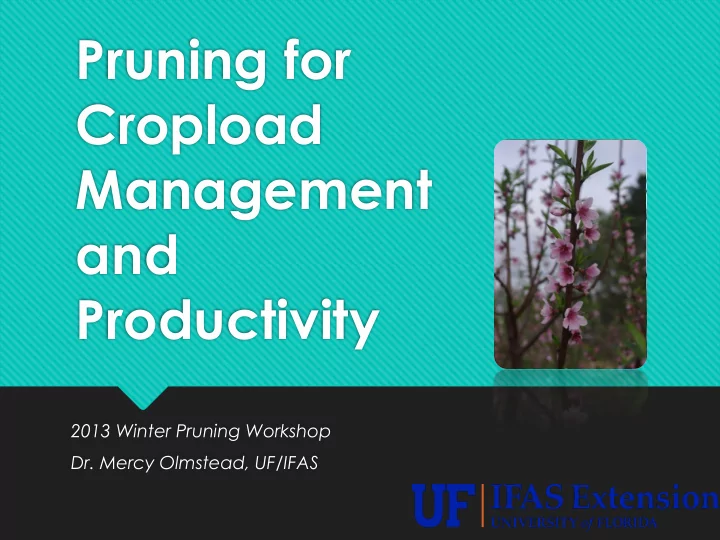

Pruning for Cropload Management and Productivity 2013 Winter Pruning Workshop Dr. Mercy Olmstead, UF/IFAS
Pruning Principles for Orchards Pruning: Develops strong tree structure Thins buds to achieve yields of high quality fruit Balances cropload with vegetative growth Especially important with short fruit developmental period in Florida (78 days vs. 120 days; temperate climates) Development of good-sized fruiting wood vs. blind wood
Blind Wood Blind Wood = No leaves to support current season’s fruit, no buds to produce future shoots - More prevalent with fast, vigorous growth
Improper Cropload Balance Tree on left has ideal cropload and canopy growth Tree on right has heavy cropload, poor canopy Thinning and pruning are important for cropload Good balance with crop and canopy Not thinned management
Terminology
Types of Pruning Cuts Heading Cuts Invigorate the tree Increase branching by causing lateral bud break Thinning Cuts Reduce branch number Encourage apical shoot elongation
Importance of Proper Pruning Manages cropload (directly) Fruiting wood cut out and reduced Need to know where bearing wood is: Peaches are borne on one-year-old wood Most pruning cuts will reduce overall yield
Peach Growth One year old wood
Pruning Principles for Orchards Manages fruit bud initiation (indirectly) Increases sunlight penetration into canopy Low sunlight will reduce the amount of flower buds formed, ultimately reducing the crop the next year. Figure 4. Flower density (flowers per meter of shoot length) of ‘ Redhaven ’ peach shoots as influenced by light levels (percent full sun) during four periods of the growing season in Virginia. R. Marini, Virginia Tech Cooperative Ext. #422-020
Pruning Principles for Orchards Maintain tree height ~ 8 feet to reduce ladder requirements Remove diseased or dead limbs In Florida, two pruning periods: Winter Summer UF2000; Botryosphaeria
Pruning Principles for Orchards Reduces canopy temperature by increasing air flow (directly) Can reduce incidence of doubling fruit
Before & After (Winter):
Before & After (Spring): R. Marini, Virginia Tech Cooperative Ext. #422-020
Before Pruning- Perpendicular V System After Pruning- Perpendicular V System
Peach Diseases Affected by Canopy Size Manages disease (indirectly) Crowded canopy with excessive growth = disease Need good air flow Photo: G. England Mainly fungal diseases: Alternaria rot Brown rot Peach Scab Vigorous canopies are difficult to cover effectively with spray
FlordaPrince vs. TropicBeauty Upright Growth Semi-spreading Growth ‘ UFBest ’ also has upright growth
Pruning and Thinning Peach Trees Extent of pruning depends on success of training system Train trees when young Use pruning to maintain initial training system Auburn University Libraries, 1926
Peach Training Systems Open Vase Traditional system In Florida, fast growth can close canopy within 2 years 7-8 feet of growth in a year Important to manage vigorous canopies with proper pruning techniques Young vs. Mature trees Training & maintaining tree balance
Open Vase Training System Prune young trees for structure: Year 1 Year 2
Open Vase Training System Mature trees must be managed to optimize sunlight interception Avoid sunburn Leave a few upright shoots in canopy center during summer pruning R. Marini, Virginia Tech Cooperative Ext. #422-020
Pruning Techniques Remove watersprouts Vigorous, upright growth Fruit produced is of poor quality Wide internode spacing Shading for lower branches Prune out diseased or dead wood Dead wood will appear greyish, while wood that is alive will be reddish-brown Peach Tree Short Life Unexplained shoot dieback
Pruning Techniques Remove limbs or branches that cross These increase shade Can cause mechanical damage on fruit Thin canopy Fruit buds require light to develop Excessive shade = higher proportion of vegetative buds Reducing fruiting wood helps to reduce thinning costs Majority of cuts in should be thinning cuts with a few heading cuts
Pruning Summary French and Appleton, Virginia Tech Cooperative Ext. #430-456 Prune to maintain productive tree Heading cuts can result in thinner fruiting wood Thinning cuts should be the majority of those made in each season.
Recommend
More recommend